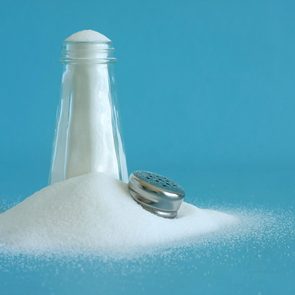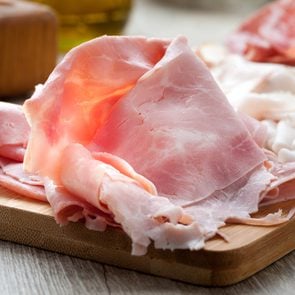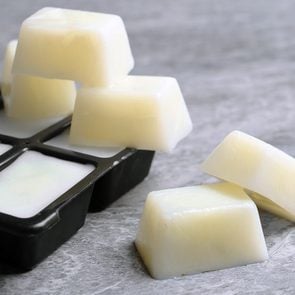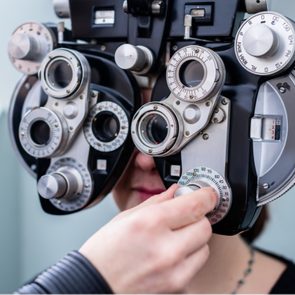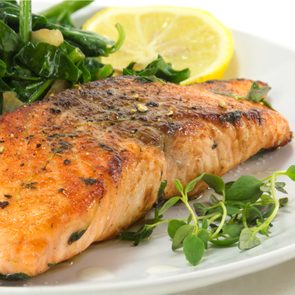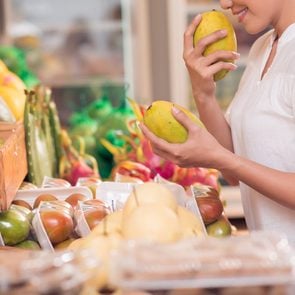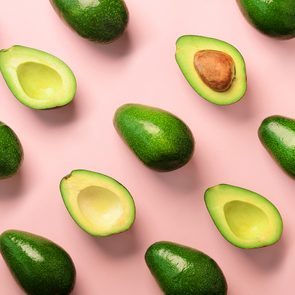Bacon comes from the belly of pigs, which is cured and smoked, giving it that irresistible scent and rich flavour. There’s more to the story than its iconic sizzle—bacon is frequently at the centre of health discussions. Backed by extensive research, the World Health Organization categorizes processed meats, including bacon, as Group 1 carcinogens. This means there are potential cancer risks with consistent, heavy intake.
Growing up, the sound of bacon crackling was an occasional treat. With a father who practiced family medicine and a mother passionate about nutrition (not to mention four hungry older brothers), we often opted for leaner turkey bacon over its pork counterpart.
As I began my week-long deep-dive into bacon consumption, I felt fond memories…but, as a trained family doctor who gained certification in nutrition coaching, I also felt some slight concern. My love for those crispy slices remains as strong as anyone’s, but I knew I’d have to pursue this wisely. Enriched with insights from experts at the Cleveland Clinic, here are the health effects I felt during my week of eating bacon.
Bacon nutrition facts
For this assignment, I leaned toward organic, uncured turkey bacon. The choice was a nod to potentially healthier alternatives, though turkey bacon is not without its own set of controversies (like its sodium content and the fact that it’s still processed meat, just to name a couple).
However, I did stray twice during the week: A weekend brunch beckoned with classic pork bacon, and I couldn’t resist a grilled chicken wrap with bacon as the signature ingredient that made it a Cobb dish.
Here are the nutrition facts for the turkey bacon I selected—note these values represent one slice:
- Total fat: 1.5 grams
- Cholesterol: 20 milligrams
- Sodium: 340 milligrams
- Total sugars: 1 gram
- Protein: 6 grams
To provide context, most of us are more familiar with the typical nutritional profile of regular bacon, primarily the kind served in restaurants. Laura Jeffers, MEd, RD, LD, a registered dietitian from the Cleveland Clinic, helped shed light on the matter:
- Protein: Both pork and turkey bacon offer substantial protein. For a 2-ounce serving, pork bacon delivers 20 grams, while turkey bacon isn’t far behind with 17 grams.
- Calories: Turkey bacon is slightly leaner, with 218 calories per 2-ounce serving, compared to pork bacon’s 268.
- Fat: Turkey bacon scores again with only 14 grams of fat versus pork’s 22 grams for the same serving size. However, both have considerable saturated fat—turkey has 4 grams and pork 8 grams. Saturated fats are linked to heart diseases.
- Sodium: Without choosing a reduced-sodium variety, you can easily surpass the daily recommended salt intake from just a few slices. The American Heart Association suggests less than 1,500 milligrams daily. Surprisingly, 2 ounces of turkey bacon carries over 1,900 milligrams, while pork bacon holds around 1,300 milligrams. High sodium doesn’t just elevate heart disease risks but also ups the chances of kidney stones.
- Vitamins: While both types provide B complex vitamins, pork bacon emerges superior. Pork also boasts more selenium, a mineral known to activate proteins that may prevent cancer. Zinc levels are comparable in both, playing a role in regulating gene activity.
Eating bacon every day for a week
With this knowledge, I began my week. The first two mornings saw bacon gracing the side of my plate next to scrambled eggs—but very soon, the allure started waning, nudging me to get innovative to see this challenge through.
Over the next few days, bacon adorned my salads and found its way into a classic BLT and grilled chicken wrap. I even ventured into making bacon-wrapped asparagus for something different to try.
The week culminated with a brunch at one of my favourite local restaurants, where I indulged in some traditional pork bacon. By this point, though, my enthusiasm for bacon had significantly waned—I was, quite frankly, baconed out.
When I ate bacon every day, I felt full
Eating bacon daily came with its revelations. Meals felt more filling. A definite fullness lingered, perhaps owing to bacon’s protein and fat content. I noticed that I stopped snacking as much—which was a major bonus.
When I ate bacon every day, I felt dehydrated
The second most noticeable effect was thirst. Post bacon meals—especially when I went out for brunch—I often found myself reaching for water more frequently. Dennis Bruemmer, MD, PhD, a preventive cardiologist from the Cleveland Clinic, echoes this sentiment in a statement, warning, “Bacon tastes fantastic, but it’s high in salt, and it’ll drive up your blood pressure.”
Find out how much water you should drink to stay hydrated.
When I ate bacon every day, I felt “bacon fatigue”
By the week’s end, something called “bacon fatigue” set in. What once felt like a treat soon morphed into a dietary imposition.
A 2022 study published in the journal Nutrients seemingly backs this up. The researchers investigated the relationship between processed meat consumption and energy levels. They analyzed the gut microbiome of 20 young adults between their mid-twenties and mid-thirties to discern any correlation between mental and physical energy and fatigue.
Interestingly, the study revealed that out of various foods, only processed meat was connected with shifts in energy dynamics—manifesting as increased mental and physical fatigue and decreased mental and physical energy. However, it’s crucial to note that the study didn’t conclusively state that consuming processed meat caused these effects, but the correlation certainly provides food for thought.
Don’t miss our ultimate guide to gut health.
Expert insights
Dr. Bruemmer’s opinions on bacon are clear and cautionary. He says, “Any animal product is probably going to be high in cholesterol content,” emphasizing that frequent consumption of bacon, known for its salt and fat content, could lead to heart issues. On the alternative choice of turkey bacon, he mentions, “Turkey is white meat and has less cholesterol, probably about 20% less cholesterol than regular pork bacon,” but warns that it’s still loaded with a significant amount of cholesterol and sodium. He recommends sticking to a Mediterranean Diet, which emphasizes fruits and vegetables and limits high-salt and high-fat animal products.
Jeffers offers a similar perspective, highlighting that the perceived health benefits of turkey bacon might be misleading. “Believing it’s the better option, you may eat too much,” she warns. Jeffers suggests that irrespective of the type—pork or turkey—one should limit bacon consumption to less than a serving a week. (Something I wholeheartedly agree with!)
Final thoughts
My week with bacon was an eye-opener. While it’s undeniably delicious, its potential health risks are undeniable, too. Incorporating feedback from clinical sources, the consensus leans toward occasional enjoyment rather than regular indulgence. This perspective isn’t diminishing bacon but respecting its place in the culinary world—as a flavourful treat, not a mainstay.
For bacon lovers, moderation paired with informed choices is the way forward—and as always, individual health conditions and advice from healthcare professionals should guide your dietary decisions.
Next, find out what happens to your body when you skip breakfast.

Can you freeze cheese?
Dairy products are notoriously fussy when it comes to freezing. But when there’s a great sale at the grocery store, it’s hard to resist the siren call of delicious two-for-$10 bricks of cheese. It doesn’t last forever in the refrigerator, but can you freeze cheese?
Yes—sometimes! The general rule of thumb is that freezing cheese will likely change its texture. If you do opt to freeze extra cheese, its best use after thawing is for cooking—the texture change becomes a moot point after it’s all melted. You probably don’t want to freeze the fancy stuff you bought for snacking on with homemade crackers, though. But frozen cheese, once thawed, would be perfect in a cheesy casserole recipe.
Sign up for our Daily Digest newsletter for more home hacks, health tips and humour, all week long.
Can you freeze mozzarella?
Blocks of mozzarella or shredded mozzarella are fine to freeze, though they tend to have a crumbly texture after freezing. Just avoid freezing fresh mozzarella, as its high water content has a likelihood of forming ice crystals.
Can you freeze cottage cheese?
Cottage cheese, along with ricotta cheese, can be frozen. However, upon thawing, both cheeses are likely to have a grainier texture. As with most frozen cheeses, thawed cottage and ricotta cheeses are best used in baked or cooked recipes.
Can you freeze cheese slices?
Yep! For prepackaged sliced cheese, just pop the package into a freezer bag and place it in the freezer. For deli-sliced cheese, place a piece of parchment paper in between each slice of cheese. Then wrap the cheese in freezer paper, tape shut and place the whole package in a freezer bag or freezer-safe container.
Can you freeze shredded cheese?
For prepackaged shredded cheese, place the package in a freezer bag before putting it in the freezer. For cheese you shred or grate yourself, place it in a freezer bag and carefully remove as much air as possible from the bag.
Now that you know how to freeze cheese, find out 13 clever cooking hacks to save time (and money) in the kitchen.

Healthy Eyes Begin with Eye Exams
The eyes may be a window to the soul, but they can also be a window to our vascular health. “It’s one of the few places where you can look inside the body,” explains Colin Mann, an ophthalmologist in Bridgewater, Nova Scotia.
For instance, since a branch of the carotid artery travels from the heart up each side of the neck and to the eyes, an optometrist can examine the blood vessels in the back of the eye to detect conditions that might not have manifested symptomatically. Narrow blood vessels in the retina could indicate high blood pressure; swelling of those same vessels might be a sign of diabetes. Left untreated, diabetes can lead to diabetic retinopathy, a condition in which high blood sugar levels damage blood vessels, eventually resulting in vision loss or blindness. As well as maintaining healthy blood glucose levels, Mann emphasizes that getting regular eye exams—at least every two years—is the best form of prevention, and an integral part of maintaining healthy eyes.
Brush up on the latest research in diabetes prevention.

Healthy Diet, Healthy Eyes
As we metabolize food, our cells produce chemical by-products called free radicals that steal electrons from nearby healthy cells, causing damage. Usually, the number of these free radicals is kept in check by antioxidants. But when antioxidant stores are depleted, free radicals can overwhelm and harm cells, leading to an imbalance known as oxidative stress. Research suggests that this imbalance occurs as we age and plays a role in the development of a number of illnesses and conditions, including cataracts. (Learn how to spot the signs of cataracts.)
Cataracts are most common in people over the age of 60 and are somewhat inevitable. In fact, cataract surgery, where the cloudy lens is removed and replaced with an artificial one, is one of the most common surgeries in Canada. The good news for people with healthy diets, though, is that foods like dark leafy greens, red berries and nuts are rich in antioxidants—including lutein, zeaxanthin and vitamin C. These can all help the body defend itself against free radicals and delay the development of cataracts.
You can also reduce your risk of cataracts by blocking ultraviolet rays with sunglasses and a wide-brimmed hat.
Find out more sun protection tips you should always follow.

Quit Smoking
“Smoking is a significant risk factor for macular degeneration, which causes vision loss,” says Shamrozé Khan, assistant clinical professor of optometry at the University of Waterloo. In fact, smokers are up to four times more likely to develop this condition, which causes the cells in the centre of the retina to deteriorate. Age-related macular degeneration accounts for 90 percent of new cases of legal blindness in Canada, according to the Canadian Ophthalmological Society.

Try Medicated Eye Drops
Open-angle glaucoma—the most common form of the condition—is caused by the clogging of drainage canals in the eye. This increases pressure in the eye and damages the fibres that make up the optic nerve (the part of the eye that transmits images to the brain).
Due to its painless, insidious nature, glaucoma often goes undiagnosed until it’s in an advanced stage; people with glaucoma may only notice it when their field of vision narrows, sometimes described as “tunnel vision.” While surgeries like a trabeculectomy, which involves creating an opening under the eyelid to allow fluid to drain, can stop the progression of the condition, the vision loss can’t be recovered. With regular eye exams, however, glaucoma can be caught early and treated with prostaglandin analogs—medicated eye drops that dissolve blockages. A similar medicated-drop treatment introduced in the 1870s needed to be administered as much as 50 times in a 24-hour period, but now, thanks to the discovery of more effective compounds, a simple once-a-day will do.
Now that you know how to maintain healthy eyes, discover 10 tips to improve your eyesight.
One of my favourite desserts to serve to family and friends is Ruthie’s Apple Cake. It is one of my go-to recipes and always turns out delicious. The cake is moist and the baked apples, infused with cinnamon, are like a big hug on a plate for the people I love. Oh, and I usually serve it with a scoop of vanilla ice cream.
But what makes this recipe even more special for me is that it is one that I inherited from my mother, Ruthie. She’s been gone for almost 25 years, but I think of her every time I bake her cake. I think it would be fair to say that for those of us who cook recipes and dishes passed down from the people we love, the why of it, is something you can almost more easily feel than articulate in words. But I’m going to try.
Passing down recipes is about more than just food
Passing down recipes is not just about cooking what came before us, and it’s not (typically) about archiving the exact ingredients, proportions, steps to follow and ensuring credit to the originator of the dish. Passing down recipes is more like sharing stories. Recipes passed down through families are full of memories of past generations, experiences, and people.
I’ve been thinking a lot about this lately, about the way food connects us. I’ve just completed a new cookbook that I’ve written with my daughter, Anna, and it has been a wonderful experience. Anna is one of those very rare people who is incredibly gifted at everything she does, including cooking. As her proud mother, it’s so meaningful to now have her as a colleague in the kitchen. I love that food is an important connection for us, and I know that, with Anna, some of my most beloved recipes, like my mother’s cake and my grandmother’s challah, will continue and thrive in our family.
Sometimes recipes are passed down with intention, parents or grandparents teaching their children about the importance of traditional dishes and their significance at the family table. And sometimes they take on new life. When people leave home for so many reasons—because of war, fear of persecution, education, employment opportunities or to reunite with family elsewhere—family-favourite recipes travel with them almost like a security blanket. Some people will search forever until they find what they need to prepare a particular dish in the way they are used to (our world is getting smaller and we are now more easily able to import specific ingredients from abroad), while others will adjust the recipe with ingredients more easily found in their new locale. None of that changes the recipe being a comforting reminder of home.
The evolution of a family favourite
While the specifics of a passed down recipe may change over time for many different reasons, the personal meaning the recipe holds does not. Case in point: I recently made Ruthie’s Apple Cake with pears. It was an accident (I was out of apples but did have pears on hand), and it was terrific. The last time Anna made the same cake, McIntosh apples weren’t available at the grocery store and so she used honeycrisp. Anna also used a measure-for-measure gluten-free flour instead of all-purpose flour, which certainly wasn’t relevant in Ruthie’s day! None of these substitutions changed what that cake means to us and the happiness it brings to us to cook it, to serve it to others and watch them enjoy it, and to think about Ruthie all through the meal. We don’t love these recipes because they are exactly the same; we cherish them because of the stories and memories they bring to mind.
The way my mom Ruthie made the cake offered a window into the culture and moment in history in which she lived and baked. She made the cake by hand. You still can, but, when I share the recipe, I also offer the option to use a stand mixer or food processor. Whereas so many cakes are covered in frosting, Ruthie’s cake is sprinkled with sugar. That’s a classic apple cake and I know from speaking to so many people that it’s the kind of dessert that was part of so many households just like ours.
In fact, I know that my husband Ray feels the same way about his mother Pearl’s apple cake that I do for Ruthie’s recipe (so much so that after almost 40 years of trying to recreate it, I still haven’t quite figured it out—but I’ll keep trying).
To me, food is such an important way to nourish and to celebrate. For example, Anna and I have been experimenting with our latke bar at home. Latkes are potato pancakes traditionally made during the Jewish holiday of Hannukah. Our family’s traditional latkes are just the way my mom made them—thin and crisp and (in my opinion) perfect. But being the cook and recipe writer I am, I can’t resist trying new things, so our family latke tradition has evolved. Anna and I now make multiple types of latkes. Sometimes we’ll use sweet potato or other root vegetables to provide a new spin to an old favourite. We’ll also serve them with some unexpected toppings. Sure, sour cream and apple sauce are always at hand, but sometimes we’ll also include smoked salmon, labneh (or Greek yogurt), tahini sauce and even guacamole.
But we always include Ruthie’s original latkes on the holiday table and remember her and my father, Max. And even though I use Yukon Golds instead of the baking potatoes Ruthie used, I still think of my parents and feel a little more whole inside.

Ruthie’s Apple Cake Recipe
This is the cake my mom made almost every Friday night. I still love it. Use McIntosh apples for the texture I like best—they do not keep their shape well and kind of melt into the cake a little—which, in this case, is a good thing. But if you can’t find them use what you have.
If you use a tube pan that has a removable bottom, wrap the outside in aluminum foil in case it leaks and spray the inside well so that you can turn it out (very carefully).
Makes 10 to 12 servings
Ingredients
- 1-1/2 cups all-purpose flour (or Cup4Cup gluten-free flour)
- 2 tsp baking powder
- 1/2 tsp kosher salt
- 2 eggs
- 1 cup granulated sugar
- 2/3 cup extra-virgin olive oil (or unflavoured vegetable oil)
- 1/4 cup orange juice
- 1 tsp pure vanilla extract
Filling: - 2 lbs McIntosh apples, peeled, cored and coarsely chopped (about 6), about 6 cups
- 2/3 cup brown sugar
- 1-1/2 tsp cinnamon
Topping: - 2 tbsp coarse sugar, optional
Method
- Preheat oven to 350F. Line a 9″ springform pan or 9″ round deep baking pan with parchment paper.
- In a medium mixing bowl whisk together flour, baking powder and salt about 60 seconds.
- In another large bowl whisk (or use a hand mixer) beat eggs and sugar until light and slowly drip in oil until well combined. Mix in orange juice and vanilla. With a wooden spoon stir flour mixture into egg mixture just until combined and no flour is left unincorporated.
- Combine apples with brown sugar and cinnamon.
- Spread about half the batter over the bottom of the pan (about 1 1/2 cups). It will not seem like enough. Don’t worry. Spoon in all the apples. It will look like too many apples. Don’t worry. Drizzle with remaining batter—also don’t worry if it doesn’t look like there’s enough. Sprinkle with coarse sugar.
- Bake 50 to 60 minutes until browned and firm in the centre or until an instant-read thermometer registers at least 185F.

Bonnie Stern is the bestselling author of 12 cookbooks and was recently inducted into the Taste Canada Hall of Fame.
From Don’t Worry, Just Cook by Bonnie Stern and Anna Rupert, published by Appetite by Random House, an imprint of Penguin Random House Canada. Copyright © 2022 Bonnie Stern Cooking Schools Ltd. and Anna Rupert. Reprinted by permission of the publisher.
Next, find out the best apples for apple pie.
Some leading health experts have been following what might sound to you like a new adage: “What’s good for the heart is good for the brain.”
It’s relatively self-explanatory: The diet and lifestyle habits that help prevent cardiovascular disorders can keep your mind sharp, too.
This probably sounds like a whole lot of discipline—you’re thinking we want you to eat more fish and go for more walks, right? We definitely support those practices—but here’s a fun twist: A beloved berry may be one of the most powerful weapons to fight off heart disease and cognitive disorders, like dementia.
According to a recent study at San Diego State University in partnership with the California Strawberry Commission, eating two servings of strawberries each day can improve heart and brain health in just eight weeks’ time.
For more wellness updates, sign up for the (free!) Reader’s Digest Health Report.

How eating strawberries can benefit brain and heart health
Recently presented at Nutrition 2023 through the American Society of Nutrition, this double-blind, placebo-controlled study evaluated 35 healthy men and women between the ages of 66 and 78 years old who consumed 26 grams of freeze-dried strawberry powder (the equivalent of two servings of strawberries, approximately two cups) for eight weeks. When compared with the control group who ate a powder that wasn’t made of strawberries, the strawberry group experienced a 5.2% increase in cognitive processing speed, a 3.6% decrease in blood pressure, and an increase of antioxidant capacity by 10.2%. Their waistlines also decreased by an average 1.1%—with unhealthy waist size indicating visceral fat, which can contribute to risk for conditions like heart disease and cardiometabolic disorders, like diabetes.
“This study demonstrates that consuming strawberries may promote cognitive function and improve cardiovascular risk factors like hypertension,” says Shirin Hooshmand, PhD, RD, a registered dietitian and professor in the School of Exercise and Nutrition Sciences at San Diego State and principal investigator on the study in a recent press release. “We’re encouraged that a simple dietary change, like adding strawberries to the daily diet, may improve these outcomes in older adults.”
If it’s not entirely practical (or appealing) to eat two cups of strawberries—or 26 grams of freeze-dried strawberry powder—every day, then Lauren Manaker, MS, RDN, LDN, CLEC, CPT, a registered dietitian and cookbook author in Charleston, SC, has other recommendations.
The strawberry isn’t the only fruit to provide these benefits
While this study highlights potential heart and brain health benefits of strawberries, Manaker points out that eating fruit is already known for supporting both heart and brain health. “Like many fruits, strawberries contain natural plant compounds that many of us are not consuming enough of. These plant compounds may support many aspects of our health, including our heart and brain health.”
One of those compounds includes flavonoids—a type of antioxidant found in most fruits and vegetables—which a 2020 review published in Molecules linked with health benefits including reducing the risk of cancer, lowering the risk of heart disease, and preserving brain function. “This [new] study specifically shows that strawberries offer impressive benefits that support both of these aspects of our health,” Manaker says.
Find out how it’s actually possible to reverse heart disease.
How to get more strawberries into your diet
Manaker says strawberries work well tossed into all kinds of healthy foods you can make at home like smoothies, parfaits, or even salads. Sliced up strawberries are great for topping on a warm bowl of oatmeal, or even in a cold cereal with milk or an overnight chia seed pudding for an extra boost of fibre and omega-3s!
To satisfy a craving for sweets, Manaker says that strawberries dipped in chocolate make for a delicious antioxidant-rich treat. “Strawberries can also be cooked and used as a topping for French toast or ice cream,” she says.
Next, find out how to feed your brain with the MIND Diet meal plan.
Picture this: You answer a phone call one day and hear a voice that sounds like your child. They tell you that they have been kidnapped and need cash for a ransom right away. You scramble to help—only to realize that the voice on the other end of the line isn’t your child but rather part of a sophisticated, terrifying new AI scam phone call.
That’s what happened to Arizona mother Jennifer DeStefano, who recently testified about her experience to the U.S. Senate. And unfortunately, her story is all too common. As artificial intelligence (AI) technology becomes cheaper and more accessible, criminals are frequently using it to impersonate the voices of our friends and loved ones to trick us into sending them money.
The good news? You can beat scammers at their own game. We spoke with cybersecurity experts to learn how these AI scam calls work, why they’re so hard to spot, how to avoid them, what to do if you become a target, the future of AI scams and more.
Sign up for our Daily Digest newsletter for more tech tips, home hacks and humour, all week long.

What is the new AI scam?
A clever scammer with a good AI program doesn’t need much more than a few-second recording of a loved one’s voice to be able to clone the person’s voice and apply their own script. From there, they can play the audio over the phone to convince their victims that someone they love is in a desperate situation and needs money immediately.
These aren’t your typical four-word phone scams or Google Voice scams. They’re even more advanced.
In one of the most common examples, parents or grandparents receive a call from their children or grandchildren claiming they need money for ransom or bail, like the AI kidnapping scam DeStefano encountered. “We have seen parents targeted and extorted for money out of fear that their child is in danger,” says Nico Dekens, director of intelligence and collection innovation at ShadowDragon.
Eva Velasquez, president and CEO of the Identity Theft Resource Center, says that the centre also receives reports of AI scam calls that convince victims their relative needs money to pay for damages from a car accident or other incident. Other scams include using a manager or executive’s voice in a voicemail instructing someone to pay a fake invoice, as well as calls that sound like law enforcement or government officials demanding the targeted individual share sensitive information over the phone.
How does this AI scam work?
It may take a few steps to pull together an AI scam, but the tech speeds up the process to such an extent that these cons are worryingly easy to produce compared with voice scams of the past. In a nutshell, this fraud follows the steps below.
Step 1: Collect the recording
To carry out an AI scam call, criminals first must find a five- to ten-second audio recording of a loved one’s voice, such as a clip from YouTube or a post on Facebook or Instagram. Then they feed it to an artificial intelligence tool that learns the person’s voice patterns, pitch and tone—and, crucially, simulates their voice.
These tools are widely available and cheap or even free to use, which makes them even more dangerous, according to experts. For example, generative AI models like ChatGPT or Microsoft’s VALL-E need to listen to only three seconds of an audio “training” clip of someone speaking to create a replica of their voice. “As you can imagine, this gives a new superpower to scammers, and they started to take advantage of that,” says Aleksander Madry, a researcher at MIT’s Computer Science and Artificial Intelligence Laboratory.
Step 2: Feed the AI a script
Once the AI software learns the person’s voice, con artists can tell it to create an audio file of that cloned voice saying anything they want. Their next step is to call you and play the AI-generated clip (also called a deepfake). The calls might use a local area code to convince you to answer the phone, but don’t be fooled. Remember, the bad guys are capable of spoofing their phone numbers. Many phone-based fraud scams originate from countries with large call-centre operations, like India, the Philippines or even Russia, according to Velasquez.
Step 3: Set the trap
The scammer will tell you that your loved one is in danger and that you must send money immediately in an untraceable way, such as with cash, via a wire transfer or using gift cards. Although this is a telltale sign of wire fraud or a gift card scam, most victims will panic and agree to send the money. “The nature of these scams plays off of fear, so in the moment of panic these scams create for their victims, it is also emotional and challenging to take the extra moment to consider that it might not be real,” Dekens says.
Scammers are also relying on the element of surprise, according to Karim Hijazi, the managing director of SCP & CO, a private investment firm focused on emerging technology platforms. “The scammers rely on an adequate level of surprise in order to catch the called target off guard,” he says. “Presently, this tactic is not well known, so most people are easily tricked into believing they are indeed speaking to their loved one, boss, co-worker or law enforcement professional.”
How has AI made scams easier to run—and harder to spot?
Imposter scams have been around for years, but artificial intelligence has made them more sophisticated and convincing. “AI did not change much in terms of why people do scams—it just provided a new avenue to execute them,” Madry says. “Be it blackmail, scam or misinformation or disinformation, all now can be much cheaper to execute and more persuasive.”
While AI has been around for decades for both criminal and everyday use—think: AI password cracking and AI assistants like Alexa and Siri—it was expensive and required a massive amount of computing power to run. As a result, shady characters needed a lot of time and expertise with specialized software to impersonate someone’s voice using AI.
“Now, all of this is available for anyone who just spends some time watching tutorials on YouTube or reading how-to docs and is willing to tinker a bit with the AI systems they can download from the internet,” says Madry.
On top of that, Velasquez notes that previous imposter phone scams used to blame a poor connection or bad accident to explain why their voice sounded different. But today’s technology “has become so good that it is almost impossible for the human ear to be able to tell that the voice on the other end of the phone is not the person it purports to be,” says Alex Hamerstone, a director with the security-consulting firm TrustedSec.
Here’s why you need to stop commenting on those viral Facebook memes.

How can you avoid AI scams?
They may be quicker to create than past imposter scams, but AI scam calls are still labour-intensive for criminals, so your odds of being targeted are low, according to Velasquez. Most con artists want to use attacks that they can automate and repeat over and over again, and “you can’t do that with voice clones because it requires the victim to know and recognize a voice, not just some random voice,” she says.
The problem is that these attacks will continue to increase as the technology improves, making it easier to locate targets and clone voices. And there’s another reason now is the best time for criminals to run these cons: “As these kinds of capabilities are new to our society, we have not yet developed the right instincts and precautions to not fully trust what is being said via phone, [especially] if we are convinced that this is a voice of a person we trust,” Madry says.
That’s why it’s important to take proper precautions to boost your online security and avoid being targeted in the first place. Here are a few suggestions from the experts:
Make your social media accounts private
Before sharing audio and video clips of yourself on Facebook, Instagram, YouTube or other social media accounts, Velasquez recommends limiting your privacy settings (including who can see your posts) to people you know and trust. Users who keep their posts open to everyone should review and remove audio and video recordings of themselves and loved ones from social media platforms to thwart scammers who may seek to capture their voices, she says.
Use multifactor authentication
Setting up multifactor authentication for your online accounts can also make it more difficult for fraudsters to access them. This system requires you to enter a combination of credentials that verifies your identity—such as a single-use, time-sensitive code you receive on your phone via text—in addition to a username and password to log in to your account.
If you use biometric tools for verification, opt for ones that use your face or fingerprint rather than your voice to avoid providing criminals with the resources to create a deepfake.
If you use any of these weak passwords, you’ll want to update your settings immediately.
Assign a secret phrase
Hijazi suggests coming up with a secret phrase or password that you can exchange with your loved one ahead of time. That way, if you receive a call alleging that they have been kidnapped or need money right away, you can authenticate that you are indeed speaking to the real person. “This does take some advance planning, but it’s a free and effective proactive measure,” he says.
Erase your digital footprint
Last, you can avoid being targeted by these scams to begin with by disappearing from the internet, as best as anyone is able to these days. Scammers often rely on the trail of breadcrumbs you leave about yourself online, from your pet’s name to your high school mascot, to learn about your life and build a scam around it.
“There are vast amounts of information freely and publicly available about almost every one of us,” Hamerstone says. “It is very simple to find out people’s family members, associations and employers, and these are all things that a scammer can use to create a convincing scam.”
The solution is simple, according to Hamerstone. “Limiting the amount of information we share about ourselves publicly is one of the few ways that we can lower the risk of these types of scams,” he says.
Online tools like DeleteMe can automatically remove your name, address and other personal details from data brokers, which will make it more difficult for scammers to target you. Google is even working on a new Results About You tool that’ll alert you when your personal info appears in its search results and will make it easy to request their removal.
What should you do if you receive an AI scam call?
Received a suspicious phone call? If you are on the phone with a loved one who is demanding money, don’t panic. “It can be scary and disturbing to hear a loved one in distress, but the most important thing to remember is not to overreact,” Velasquez says.
Instead, experts recommend taking these steps before agreeing to send money to someone over the phone:
- Call your loved one directly using a trusted phone number.
- If you can’t reach them, try to contact them through a family member, friend or colleague.
- Ask the caller to verify a detail that only they would know, such as the secret phrase mentioned above.
- Alert law enforcement. They can help you verify whether the call you received is legitimate or a scam, Dekens says.
- Listen for any audio abnormalities, such as unusual voice modulation or synthetic-sounding voices, to identify a scammer. “Deepfake audio can lack natural intonation or exhibit glitches, like sounding angry or sad,” Dekens says. Hijazi also points out that this technology is not “conversational” yet and will likely fail to keep up if you keep asking questions.
- If you determine that the call is a scam, write down or screenshot the phone number that called you.
- Block the number on your phone to avoid receiving a call from them again.
- Dekens suggests putting the scam caller on speaker on your phone and recording the audio with a secondary phone. “It is a good way to preserve evidence,” he says.
- Report the call to your mobile phone carrier so the company can take appropriate action.
Next, brush up on the latest scams on the rise across Canada.
I’ve been invited to a ton of weddings, and shopping for the perfect wedding gift for the happy couple is actually something I enjoy—I love to scroll through registries to learn the couple’s tastes and needs. But one wedding I was recently invited to gave me pause. The bride was a former co-worker, and while we were close 10 years ago, these days our communication is limited to following each other on social media and sending holiday cards. Adding to my uncertainty about how to RSVP was that the wedding was across the country. Ultimately, I decided not to attend. But I had no idea what the correct wedding gift etiquette is in this situation. Do you need to send a wedding gift if you don’t attend? If so, how much should you spend, especially when the couple isn’t among your closest friends or family? I was at a loss—but I wanted to make sure I was following proper etiquette.
“Gift giving can be tricky, especially when it comes to weddings,” agrees Jacqueline Whitmore, founder of the Protocol School of Palm Beach. To take the stress out of finding the perfect present—or not—follow these expert-approved wedding gift etiquette rules.

1. Consider your relationship to the couple
Gift giving takes thought and care, says Nikki Sawhney, director and founder of the New England School of Protocol. “Be mindful of what and who the gift is for,” she says. “Wedding gifts are given based on your relationship with the bride and groom.” If you are close to the couple, you might want to get them something more personal, such as monogrammed towels or bedding, adds Whitmore.
2. If a couple has a registry, use it
A couple takes the time to pick out exactly what they want from a store to help take the guesswork out of wedding gift confusion for their guests, says Sawhney. Is the registry picked over? Send the couple a gift card to the same store, since they obviously like it. Popular registries include department stores and housewares and home decor retailers, as well as home-improvement stores.
3. Spend what you can afford
While a recent Bankrate.com survey found that most guests plan to spend an average of $180 USD per wedding present, you should always gift what falls comfortably within your budget. “Who says you have to spend big? Don’t get hung up on dollar amount,” says Whitmore. The golden rule of gift giving still applies to weddings—it’s the thought that counts. Case in point: One of my most cherished gifts from my wedding is a handmade quilt from my aunt. It didn’t cost a lot, but my husband and I still snuggle under it on our sofa and always think of her.
4. Budget for other wedding-related events
Are you invited to an engagement party, bridal shower and the wedding? Create a budget and prioritize the gift based on what you think is most important, says Sawhney. “The 20-20-60 rule suggests that you spend 20% of your budget on the engagement gift, 20% on the bridal shower and 60% on the wedding gift,” she says.
Don’t miss our ultimate guide to email etiquette.
5. Remember other related expenses
According to the same Bankrate.com survey, wedding attendance costs are adding up: In 2023, guests plan to spend an average of $611 USD per wedding, including the gift, travel-related expenses and attire. If you are in the bridal party and have already reached your gift-giving threshold because you contributed toward other expenses, such as hosting a bachelorette party or buying a bridesmaid dress or groomsmen suit, then you can give a small token gift for the ceremony. “You don’t have to break the bank or take out a loan to buy the bride and groom a gift,” says Sawhney. If you find your budget is close to being tapped out, it can be helpful to set real expectations up front with the bride and groom in an honest, polite and respectful manner.
6. Send a wedding gift ahead of time
While you should bring a shower gift to the actual shower, it may be easier for the couple if you send a wedding gift to their home. Think you’ve got up to a year to send a gift? “While that was the rule for years, it’s now considered proper etiquette to send a wedding gift before the wedding or within three months of the couple getting married,” says Whitmore. Why the change? The world moves faster than ever now, and online shopping and overnight or two-day shipping are now fairly standard. Plus, you don’t want to risk running into the couple six months after the wedding and they wonder why you never acknowledged their wedding, she explains. Make sure you have it gift-wrapped and include a card—and a gift receipt if possible. “Don’t rush through it or just scribble your name on the card. Take your time and put in some care and effort,” says Sawhney.
7. Consider the couple’s lifestyle
If the couple doesn’t have a registry, finding the perfect gift make take a bit of detective work. If you don’t know them well, ask their friends or family what they might like, or scroll through their social media feeds. Does the couple love to travel? Perhaps a gift card to their favourite hotel, airline or luggage company might be appreciated. Are they homebodies? Bedding or home decor might be perfect for them. Are they foodies? A gift card to their favourite restaurant or bottle of wine might be a treat.
Here’s what you should keep in mind when planning a destination wedding.

8. Fund the honeymoon
That said, many brides and grooms today also have a dedicated website where you can find out more detailed information about their wedding, including gift options. “Often, the couple will list a preference on receiving cash or contributing to a fund that will help pay for their honeymoon or a down payment on a home,” Sawhney says. Some couples even suggest a contribution to a charity of their choice in lieu of a gift.
9. Send something even if you don’t go
“If you cannot attend a wedding, it is not a requirement that you send a gift,” says Sawhney, “however, it is a nice gesture, especially if you are close to the couple.” Choose a token gift of nominal value from their registry or for their new home. “Pretty photo frames to show off their wedding photos are always a good option,” says Whitmore. At the very least, send a card of heartfelt congratulations. As for my own dilemma, I sent my far-away friend a gift card to Williams-Sonoma (where she had registered). I placed it in a pretty wedding-themed box and mailed it off with a clear conscience and joy that my old pal found love.
10. Cash is still king
“Many couples today prefer cash,” says Sawhney. While it’s common to bring a card with cash or a check to the wedding, consider popping it in the mail ahead of the wedding day. “A box of envelopes full of cash at the reception can be a disaster waiting if it gets misplaced,” warns Whitmore. Prefer to write a check? If you’re not sure who to make it out to, it’s best to use just one name so it’s easier to cash. Then write a memo on the check and be sure to address both people on the card and envelope. With your gift safely sent ahead of the big day, you’ll be able to focus on what really counts at the wedding—celebrating with the happy couple.
Next, check out 17 etiquette rules we should never have abandoned.

How to Improve Indoor Air Quality at Home
Ventilate when using gas stoves
More than six million Canadians use natural gas for cooking, heating and electricity. But experts have recently raised concerns about the impact gas stoves can have on indoor air quality: Unlike electric and induction types, gas stoves give off nitrogen dioxide (NO2) when ignited—and often at levels that exceed the safety limit set by the World Health Organization.
The NO2 can cause coughing and wheezing, and people with asthma and chronic obstructive pulmonary disease may experience inflamed airways as well. A 2023 study published in the International Journal of Environmental Research and Public Health found that in the U.S., where two out of five homes use gas stoves, 12.7 percent of childhood asthma cases can be attributed to their use in the home.
To protect your indoor air quality, turn on the extractor fan every time you cook; they’re designed to remove smoke, grease and pollutants that are released during cooking. But less than 20 percent of people use them consistently, says Brady Seals, a co-author of the study and a manager with the environmental think tank RMI in Colorado. “Use the back burners, as they’re closer to the exhaust intake, and open a window—even for just five minutes.”

Avoid Volatile Organic Compounds (VOCs)
VOCs, including benzene and formaldehyde, are sometimes found in household items like paint, carpeting and detergents. While most VOCs do not pose a significant health risk, a 2005 study published in the Journal of Occupational Health found prolonged, concentrated exposure in workplaces—such as industrial factories or nail salons—to be associated with cancer, liver damage and neurological problems.
To reduce your exposure, choose paint and furnishings that are certified as low or no VOC. When using cleaning products, especially those containing bleach, ventilation is key, says Trevor VandenBoer, an environmental-chemistry researcher at York University in Toronto. “Use an exhaust fan, open a window and give the room time to air out—ideally an hour.”
Many VOCs stick to other particles, such as dust, skin flakes and lint, so VandenBoer recommends an activated carbon filter air purifier. Make sure it can capture particulates less than 2.5 microns in diameter (about one-30th the width of a human hair) because that’s the size that can be inhaled deep into your lungs. And vacuum often with a high-efficiency particulate air (HEPA) filter that traps small particles.

Use a radon detector
An invisible, odourless gas that comes from the breakdown of uranium in soil, radon leaches into the home from cracks and construction joints in the foundation (whether you have a basement or not) and can waft up several levels. Inhaling high levels of radon, especially over many years, can cause malignant cell growth in the lungs, making radon one of the leading causes of lung cancer worldwide. In Canada, it’s second only to cigarette smoke.
Experts say a radon test kit (above) should be as essential as smoke and carbon monoxide alarms. This hockey puck-shaped item, called a dosimeter, must be placed in your home’s lowest occupied level for at least three months since radon levels can vary daily. If your dosimeter indicates unsafe levels (more than 200 bq/m³), a radon-mitigation expert can fix the problem by installing a ventilation pipe in your home’s foundation.

Combat mould growth
Common household moulds like aspergillus, penicillium and cladosporium are present in 13 percent of Canadian homes. They’re mostly harmless, but when damp indoor conditions encourage growth, they can release dust-like spores into the air. This can trigger allergic reactions, leading to eye, nose and throat irritation, sneezing, coughing and even asthma attacks.
Patches of black or green specks can appear on walls, tile or ceilings, along with a musty odour. Small patches can be cleaned with white vinegar or dish detergent, but if the affected area is larger than a bath towel, call a mould-removal specialist. Mould hides inside the walls, where it’s not always visible, so it’s best to mitigate the growth.
As a habit, turn on an exhaust fan in the bathroom and run a dehumidifier to keep humidity levels below 50 percent. Most dehumidifiers have a built-in hygrometer that measures the air’s humidity; home-humidity meters are also widely available.
Now that you know how to improve indoor air quality, check out our ultimate healthy home checklist.
Collecting Old John Deere Tractors
My first total tear-down was the 1947 John Deere D. It came from a college friend’s farm, about 400 miles away, and had been used on their farm forever!
Back then, it had a hay sweep on the front for stacking loose hay. No GPS or power steering in those days; it was slow and awkward but hard-working and reliable. In later years, it pulled a manure spreader, and then sat idle in a shed for many years.
A veteran John Deere mechanic had it started within an hour, after removing a big pailful of seeds, pine cones and other tidbits from the radiator and other nooks and crannies that had been stashed away over the years by rodents.

The Rebirth of JD D
Although the engine of this old John Deere tractor turned over with minimal effort, the JD D was in need of a complete overhaul to make it fully functional. So, the whole machine was torn down—engine, transmission, body and everything in between. The parts were refurbished or re-built where necessary, and it was reassembled. I kept the original old tires on it, in keeping with the overall feel of a hard-working farm tractor.
It puts out 45 horsepower through its two horizontal pistons; it has a right-side hand clutch and a huge old flywheel, which together give it the ability to pull down to low rpms yet keep lugging a load. “Our Johnny Popper,” as I like to call it, is still my favourite toy to bring to “show and go” events. It’s even pulled a three-bottom plow at our local Tractor Club Plow Days.

A Unique Gibson
My wife’s 1947 “custom-built” Gibson was made by a neighbour who lived in the village nearby. He was a mastermind at rebuilding rare machinery—anything with a motor—from scratch. This creation started out from the basic scraps of an original Gibson, but the motor is from a swather, the gearbox from a big loader and other missing parts were found, made or adapted as his ingenuity dictated.
This model of Gibson tractor came from the factory with tiller steering (no wheel) and a three-point hitch lever. It would’ve been used in an orchard or for garden work. The blade on my wife’s custom Gibson is from a modern garden tractor, added mainly as a conversation piece, although it works and can serve its intended purpose. The green paint job is not factory original because the man who built it chose to paint each of his creations a different colour.
I bought it for my wife’s 65th birthday, as the builder was downsizing at that time. I am glad that he had an opportunity to see the unmistakable joy on her face while she was driving it in town parades and at events at the nearby museum.
An original Gibson tractor, of which there were three models, would’ve sold for between $760 and $845. It was produced by Western American Industries in Longmont, Colorado. The advertising slogan was “Big tractor performance on small farms.”

A “Win-Win” Trade
The 1947 John Deere A, 35 HP, came to me in a horse trade, which involved a couple of old JD carcasses I had in my possession that a local master rebuilder wanted. The JD A was an extra for him, so it was a win-win trade. I remember our neighbours by our old farm had this model while I was growing up, and we would use it for haying. What a thrill for a kid to drive! Sitting up high, I felt like the king of the road. With its tricycle wheels, it turned very short, which could prove to be very dangerous if one hit the wheel brake on one side only!
Tiny & Tough Case D
The orange 1952 Case D, 35 HP, was tucked away in a farm shed about 300 miles away, intact and complete. It was trailered home and an old farm friend adept with Case machines quickly had it running. The body repair and painting followed. The J.I. Case Company was named after its founder, Jerome Increase Case—oddly enough, his actual name.
On our old farm, this model was our only tractor for years. I remember plowing, harrowing and baling with it. It wasn’t easy to work with, especially in tandem with an Allis-Chalmers Roto-Baler. Because it didn’t have live PTO (a two-stage clutch), for every bale you had to stop the tractor, take it out of gear, roll the bale through to the kick-out, then put it back into gear and go again, slow but sure. That model had a curved cast-iron grill that was real solid. We had a mean old Angus bull that decided to charge the tractor head-on one day. Whammo! He was stunned, but he backed up and charged it a second time, but never again—lesson learned! It was tiny, but tough.

Meet Deere John 2510
The 1967 John Deere 2510, 55 HP, with an eight-speed synchro transmission and a three-point hitch was our only yard tractor for years, and still serves as a backup. It had been a row-crop tractor, with V-shaped front tires and row-crop adjustable axles. After a lot of cleanup and repair work, it was painted. A Soo loader was painted to match, and then added in May 1987.
And that’s where our collection of functional tractor history stands today. As you can probably tell by now, I’m always happy when I get a chance to recall and share the simplicity of those “Deere old days.”
If you enjoyed looking back at these old John Deere tractors, check out a stunning gallery showcasing the Canadian Prairies.

Boblo Island Memories
Growing up in a sleepy little southern Ontario burg, across from an amusement park in the middle of the Detroit River, was an interesting childhood. Many of the local kids worked on Boblo Island when they turned 15, including me. We were a crew of around 30 people and were in charge of painting the massive long dock yellow, where the huge old paddle boats from Detroit, and the smaller ferries from Amherstburg, Ontario, would anchor and unload the happy, noisy tourists all summer long.
Boblo Island opened for business in 1898 and closed in 1993, but I still consider it a pleasure to write one of the many wondrous stories about it. My father took me there in the late 1960s, and it was a magical place. I remember the smells of cotton candy, hot dogs, corn on the cob, roasted peanuts, and French fries. The park also played popular music hits through their squeaky loudspeakers and had many different rides—that got more numerous every year. Folks came from far and wide, as it was quite an attraction. There was the Whip, the bumper cars, the putt-putt mini golf with cement-reinforced canals that ran throughout the course, the old Model T cars you could drive yourself, and the very scary Cat and Mouse roller coaster. That ride had 90-degree turns without any type of banking and after your first ride, if you weren’t completely insane, you never went on it again.

One of my favourites, however, was the Jet-ride. Its design allowed you to sit in cool metal jet planes, connected by massive steel tubes and ride-goers could actually use controls to make it go up and down, as you went around and around, very high in the air. The loud hissing and puffing of the steam, the clanking of the gears, loose bolts, and old metal parts always evoked anxiousness.
When I got older and started working on the island, I would show up at sunrise, before all the other kids, waiting for the ferry to take me across the river. I still remember the damp ground and dew of the cool mornings, the boat ride across, and the spray of mist on my face. I was lucky enough to spend several summers working on the island, before I went onto other things. No matter what was going on in my life, once I arrived on that magical island sanctuary, in the middle of the river, I had escaped and was free as a bird. No teachers or bullies to bother me.
After the island closed, it became a residential development property. A few celebrities, including Tim Allen, bought houses there.

A Long-Awaited Return
More than 40 years later, I embarked on the current Boblo Island ferry and it was surreal being out on that river again. Parking my rental car at the restaurant, I walked towards the west side of the island, to see if White Sands beach was still there. My father had helped to create that beach with the US Army Corps of Engineers, and the tonnes and tonnes of sand needed was brought in from elsewhere. I passed by the old War of 1812 log house and a few of the old rides were still there, too, but long since inoperative. I eventually found the beach. The sand was hot enough to almost burn my feet and so I decided to relax on a picnic table with a cold beer, while watching a few boaters play volleyball.

I started my long walk back towards where the old dock once stood. I doubted that it could still be there, after 100+ years. As I made my way down the trail, seeing deer out in the fields through the trees, and walking past the bushes and lighthouse, I spotted an old, derelict building in the middle of an overgrown field, and went to look inside. As I got closer, my heart skipped a beat as I realized it was the old bumper cars ride! To this day, I am a huge Formula 1 racing fan, and seeing the old bumper cars reminded me of my mother encouraging me to try that ride, since it was the closest I might get to being an actual F1 driver! I looked inside and saw the large wooden beams, still supported by huge coil springs, lining the bottom of the walls. Even the steel-grid fencing on the ceiling that the electric poles used to power the cars, where all the sparks would fly, was still there! I could almost hear the laughs and howls of the ghosts of past park visitors. Memories from my wonderful childhood came rushing back, but the real treat was still ahead.
Walking ahead, past stands of bushes, there it was, the old dock! I marvelled at its ancient appearance and the old sign at the top of it. The dock was all dusty, with overgrown weeds tangled through the cracks. There was no gate or anything stopping me, so I slowly walked down the concrete walkway, taking in the familiar old sights. The aquamarine-coloured water and my old town across the river had me reliving my childhood like never before. I strolled up to the rusty guardrails and noticed the old blue paint chipping away. I stood inside the tiny abandoned ticket shack and was again flooded by emotions.
As I walked back to the car, with melancholy settling in, something caught my attention off to the right, through the trees and bushes. I made my way over to investigate. I bushwhacked my way through the heavy brush and, low and behold, there it was. I set my eyes on the heavily overgrown putt-putt golf course, with all the empty cement canals filled with dead leaves, that twisted throughout the links. This entire visit overwhelmed me with childhood memories. Getting off the Amherstburg ferry, walking up the rickety gangplank and paying for my tickets on those hot sunny summer days, as a bright-eyed and carefree boy. It was an incredible feeling and I nearly cried thinking how much time had gone by. All my years spent living out west made me miss the time I spent at this amusement park and with my father as well.
Next, brush up on the haunting history of Balaclava, Ontario’s most famous ghost town.
